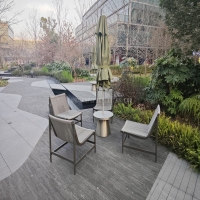Welcome to the website for landscape facilities products and knowledge.
How does the table’s surface interact with hot items like coffee cups or dishes?
When you place a hot coffee cup or freshly cooked dish directly onto a table surface, an immediate thermal interaction occurs that varies significantly depending on the table material. Solid wood tables, for instance, undergo cellular expansion when exposed to heat, which can create permanent white rings or cloudiness in the finish as the heat disrupts the protective coating. Glass tables, while generally heat-resistant, can experience thermal shock if subjected to extreme temperature differentials, potentially leading to cracks or fractures in rare cases.
The composition of your table surface determines its vulnerability. Natural materials like wood are particularly susceptible because heat draws out their natural moisture, causing the fibers to contract and expand unevenly. This process creates what we commonly recognize as heat marks - those frustrating white or cloudy spots that appear in the finish. Laminated surfaces and engineered wood products may experience delamination, where the heat causes the layered materials to separate or bubble. Even sturdy materials like stone or quartz, while more heat-tolerant, can suffer from thermal stress over time, especially if the heat is concentrated in one area.
Modern table designs often incorporate heat-resistant coatings and treatments. Many contemporary tables feature advanced lacquers and conversion varnishes that provide enhanced thermal protection. Some manufacturers now incorporate heat-resistant barriers directly into the table's construction, creating an invisible shield against thermal damage. The thickness and quality of these protective layers significantly influence how well the table withstands hot items.
The duration of heat exposure plays a crucial role in potential damage. A brief contact with a warm mug may cause no visible effect, while prolonged exposure to a hot serving dish can permanently alter the table's surface. The temperature threshold varies by material - most wood surfaces begin showing damage at temperatures exceeding 120°F (49°C), while engineered materials can typically withstand up to 140°F (60°C) without visible effects.
Practical protection methods remain essential regardless of your table's material quality. Using coasters, trivets, and placemats creates a crucial insulating barrier that distributes heat more evenly and prevents direct contact. For regular hosting, consider investing in specialized heat-resistant pads or silicone mats that offer superior protection while maintaining aesthetic appeal. Regular maintenance, including prompt cleaning of spills and application of appropriate protective products, can further enhance your table's resistance to thermal damage.
Understanding these interactions empowers you to make informed decisions about table care and selection. If you frequently entertain with hot dishes, prioritizing tables with inherent heat resistance or implementing consistent protective measures will preserve your furniture's beauty and longevity. The relationship between your table and hot items doesn't have to result in damage - with proper knowledge and precautions, you can maintain a pristine surface while enjoying the convenience of direct serving.
Related search:

Recommendation
Metal structure rattan chair without armrests for single person, with woven seat and backrest.